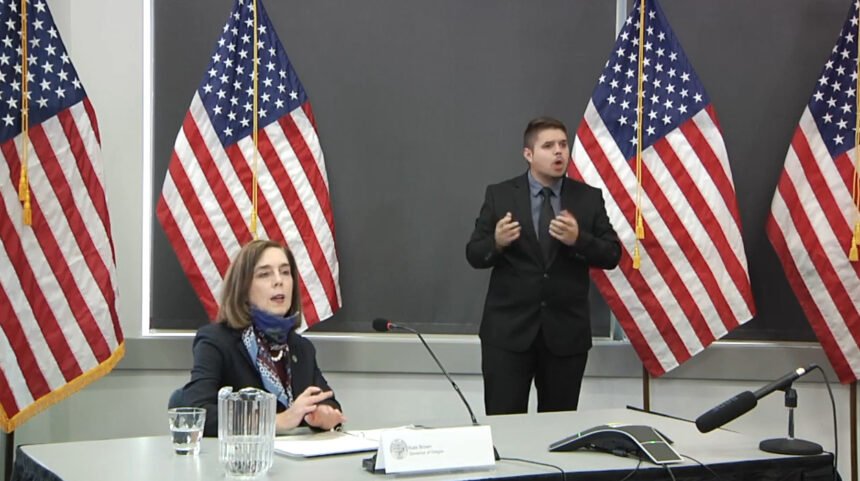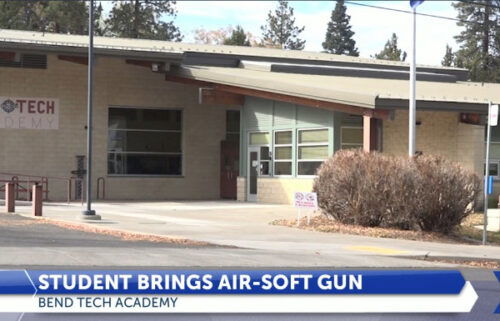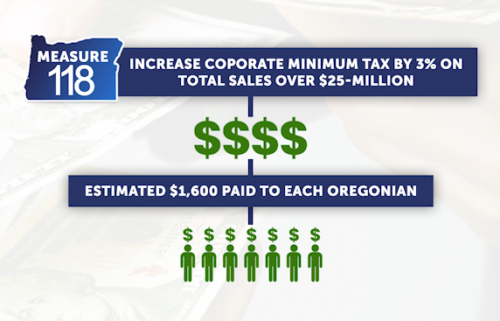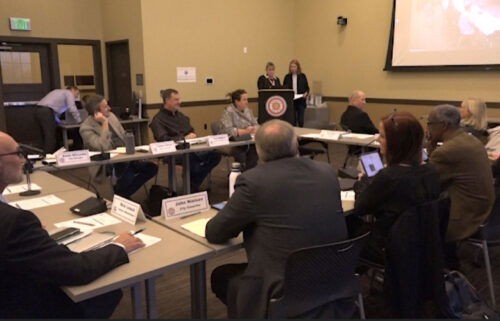Gov. Brown declares 2-week statewide freeze in bid to curb COVID-19 case spike

Crackdown includes enforcement: 'Unfortunately, we have no other choice'
(Update: More details of two-week freeze)
West Coast states issue travel advisories; Oregonians urged to avoid 'non-essential travel'
SALEM, Ore. (AP) — Oregon Gov. Kate Brown announced Friday a statewide two-week “freeze” that includes limiting restaurants and bars to take-out only and shuttering gyms, indoor and outdoor recreational facilities.
The freeze, which will be in effect from Nov. 18 through Dec. 2, aims to limit group activities and reduce the spread of COVID-19.
The state is experiencing a spike in daily case counts and reached record daily highs in confirmed cases and positivity rates in November.
Brown has long warned about implementing tighter restrictions if Oregon’s cases did not decrease. The latest set of restrictions are the most stringent since the start of the pandemic.
As part of the freeze, grocery stores, pharmacies and retail stores are limited to a maximum capacity of 75%. Faith-based organizations will also have their capacity reduced to 25 people indoors and 50 people outdoors.
However, other facilities — gyms and fitness centers, museums, pools, sports courts, movie theaters, zoos, gardens, aquariums and venues — will have to close their doors completely.
Restaurants and bars, which had a capacity limit of 50-100 people depending on the county and curfew of 10 p.m., will now be limited to take-out only.
All businesses will be required to close their offices to the public and mandate work-from-home “to the greatest extent possible,” Brown said.
Lastly, both indoor and outdoor social get-togethers are limited to six people, total, from no more than two households. In the past, Brown has described social get-together measures as “self-enforced.”
“These risk reduction measures are critical in limiting the spread of COVID-19, reducing risk in communities more vulnerable to serious illness and death, and helping conserve hospital capacity so that all Oregonians can continue to have access to quality care,” the governor’s office said Friday.
The freeze does not apply to barber shops, hair salons, congregate homeless sheltering, outdoor recreation and sports, youth programs, childcare, and K-12 schools that are currently open.
Brown and the governors of California and Washington issued travel advisories Friday urging residents to avoid non-essential travel out-of-state and asking people to self-quarantine for 14 days after arriving from another state or country.
Toward the end of the news conference, after explaining the delay until Wednesday is to give businesses time to prepare for full compliance, Brown was blunt in her message to Oregonians, after months of urging, even pleading for voluntary action in the past.
“In terms of individuals, I am not asking you -- I am telling you to stop your social gatherings, your informal social gatherings, and your house parties, and to limit your social interactions to six and under, not more than one household. And I'm asking that immediately.” Brown said.
"I will take stronger action as appropriate," she added. “I’ve already directed the superintendent of (Oregon) State Police to work with local law enforcement to legally enforce the informal social gathering orders.”
"I will be issuing an executive order regarding these restrictions, and as before, as always, these are enforceable by law," Brown said. "Law enforcement has the discretion to enforce these. They are Class C misdemeanors, and they can be enforced through a citation, a fine or through an arrest." (Class C misdemeanors carry a fine of up to $1,250.)
"Obviously, for the last eight months, I have been asking Oregonians to follow the letter and the spirit of the law, and we have chosen not to engage law enforcement," the governor said. "At this point in time, unfortunately, we have no other option."
News release from Gov. Brown:
Governor Kate Brown Announces Statewide Two-Week Freeze to Stop Rapid Spread of COVID-19
New measures take effect Wednesday, Nov. 18, in all Oregon counties
(Portland, OR) — Governor Kate Brown today announced a statewide Two-Week Freeze, implementing new measures to limit gatherings and stop the rapid spread of COVID-19 across Oregon. The Two-Week Freeze measures will be in effect from Nov. 18 through Dec. 2, statewide. These risk reduction measures are critical in limiting the spread of COVID-19, reducing risk in communities more vulnerable to serious illness and death, and helping conserve hospital capacity so that all Oregonians can continue to have access to quality care.
“Since I announced a Two-Week Pause one week ago, we are seeing an alarming spike in both cases and hospitalizations,” said Governor Brown. “The virus is spreading in the community and, every day, it is infecting more and more Oregonians. This situation is dangerous and our hospitals have been sounding the alarms. If we want to give Oregon a fighting chance, we must take further measures to flatten the curve and save lives. I know this is hard, and we are weary. But we are trying to stop this ferocious virus from quickly spreading far and wide. And in Oregon, we actually can do this.
“Given the data and modeling we are seeing, my public health experts tell me that some counties will need longer to flatten the curve. So I want to be very clear that there are some COVID-19 hotspot counties that will likely need to stay in the Freeze for much longer than two weeks. Multnomah County, for example, will be in this Freeze for at least four weeks. Our actions right now, no matter where in the state you live, are critical.”
The Two-Week Freeze measures include:
- Limiting social get-togethers (indoors and outdoors) to no more than six people, total, from no more than two households.
- Limiting faith-based organizations to a maximum of 25 people indoors or 50 people outdoors.
- Limiting eating and drinking establishments to take-out and delivery only.
- Closing gyms and fitness organizations.
- Closing indoor recreational facilities, museums, indoor entertainment activities, and indoor pools and sports courts.
- Closing zoos, gardens, aquariums, outdoor entertainment activities, and outdoor pools.
- Limiting grocery stores and pharmacies to a maximum of 75% capacity and encouraging curbside pickup.
- Limiting retail stores and retail malls (indoor and outdoor) to a maximum of 75% capacity and encouraging curbside pickup.
- Closing venues (that host or facilitate indoor or outdoor events).
- Requiring all businesses to mandate work-from-home to the greatest extent possible and closing offices to the public.
- Prohibiting indoor visiting in long-term care facilities (outdoor visitation permitted for supporting quality of life).
The Two-Week Freeze does not apply to or change current health and safety protocols for personal services (such as barber shops, hair salons, and non-medical massage therapy), congregate homeless sheltering, outdoor recreation and sports, youth programs, childcare, K-12 schools, K-12 sports currently allowed, current Division 1 and professional athletics exemptions, and higher education — all of which can continue operating under previous guidance issued by the Oregon Health Authority.
For all other permitted activities listed above, the Oregon Health Authority will be issuing sector-specific guidance within the next week. Sectors without specific prohibitions or guidance must operate under this general employer guidance.
Governor Brown's full remarks are available here.
A link to Governor Brown's press conference is available here.
Earlier story:
SALEM, Ore. (KTVZ) — The governors of Oregon, California and Washington issued travel advisories Friday, urging people entering their states or returning from outside the states to self-quarantine for two weeks to slow the spread of the coronavirus.
The advisories urge people to avoid non-essential out-of-state travel, ask people to self-quarantine for 14 days after arriving from another state or country and encourage residents to stay local, a statement said.
“California just surpassed a sobering threshold – one million COVID-19 cases – with no signs of the virus slowing down,” California Gov. Gavin Newsom wrote. “Increased cases are adding pressure on our hospital systems and threatening the lives of seniors, essential workers and vulnerable Californians.”
Oregon Gov. Kate Brown said in a social media video Thursday, “If we do not act immediately we will soon reach a breaking point.”
Washington Gov. Jay Inslee sounded a similar warning.
“We have to rethink spending time with people from outside our households right now, including Thanksgiving and the December holidays,” he wrote on social media. “This is temporary. We will get back to normal. But right now, it is just too dangerous to gather.”
News release from Gov. Kate Brown's office
Oregon, California & Washington Issue Travel Advisories
In light of rising cases, West Coast states issue travel advisories recommending 14-day quarantines for inter-state and international travel; asks residents to stay local
[Note: Governor Brown will still be holding a press availability at noon to discuss further measures to stop the spread of COVID-19 in Oregon]
(Salem, OR) — As COVID-19 cases continue to increase across the country, Governor Kate Brown, California Governor Gavin Newsom, and Washington Governor Jay Inslee issued travel advisories today urging visitors entering their states or returning home from travel outside these states to self-quarantine to slow the spread of the virus. The travel advisories urge against non-essential out-of-state travel, ask people to self-quarantine for 14 days after arriving from another state or country, and encourage residents to stay local.
“COVID-19 does not stop at state lines. As hospitals across the West are stretched to capacity, we must take steps to ensure travelers are not bringing this disease home with them,” said Governor Brown. “If you do not need to travel, you shouldn’t. This will be hard, especially with Thanksgiving around the corner. But the best way to keep your family safe is to stay close to home.”
In addition to urging individuals arriving from other states or countries to self-quarantine for 14 days after arrival, the states’ travel advisories recommend individuals limit their interactions to their immediate household. The advisories define essential travel as travel for work and study, critical infrastructure support, economic services and supply chains, health, immediate medical care, and safety and security.
“California just surpassed a sobering threshold – one million COVID-19 cases – with no signs of the virus slowing down,” said California Governor Gavin Newsom. “Increased cases are adding pressure on our hospital systems and threatening the lives of seniors, essential workers and vulnerable Californians. Travel increases the risk of spreading COVID-19, and we must all collectively increase our efforts at this time to keep the virus at bay and save lives.”
“COVID cases have doubled in Washington over the past two weeks. This puts our state in as dangerous a position today as we were in March,” Washington Governor Jay Inslee said. “Limiting and reducing travel is one way to reduce the further spread of the disease. I am happy to partner with California and Oregon in this effort to help protect lives up and down the West Coast.”
To learn more about the risk that travel itself poses for COVID-19 exposure, please visit the CDC page on travel risks.
Oregon Travel Advisory 11/13/2020
The incidence of COVID-19 is increasing in many states and countries. Persons arriving in Oregon from other states or Oregonians returning from other states or countries could increase the risk of COVID-19 spread. In addition, travel itself can be a risk for exposure to COVID-19, particularly travel through shared conveyance such as air, bus or rail travel.
Travel Advisory for Non-Essential Travel
1. Persons arriving in Oregon from other states or countries, including returning Oregon residents, should practice self-quarantine for 14 days after arrival. These persons should limit their interactions to their immediate household. This recommendation does not apply to individuals who cross state or country borders for essential travel.
Non-essential travel includes travel that is considered tourism or recreational in nature.
Essential travel includes: work and study, critical infrastructure support, economic services and supply chains, health, immediate medical care, and safety and security.
2. Oregonians are encouraged to stay home or in their region and avoid non-essential travel to other states or countries. Avoiding travel can reduce the risk of virus transmission and bringing the virus back to Oregon.



